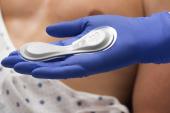Safe to Upgrade From Pacemaker or Defibrillator to CRT
Experienced operators had good success upgrading to CRT, but required advanced techniques in patients with occlusive disease.

Upgrading a patient from an existing permanent pacemaker or implantable cardioverter-defibrillator (ICD) to a cardiac resynchronization therapy (CRT) device can be successfully and safely done in the hands of experienced operators, according to a new analysis from a large tertiary center.
When compared with patients undergoing de novo CRT implantation, the rates of procedural success and complications at 90 days were similar in patients undergoing the procedure for an upgraded device, researchers report.
The need for an upgrade is relatively common, write David Nemer, MD (Cleveland Clinic, OH), and colleagues in the January 2021 issue of JACC: Clinical Electrophysiology. CRT is indicated for the treatment of patients with systolic congestive heart failure and electrical dyssynchrony; however, roughly 20% to 30% of all CRT devices are upgrades from an existing pacemaker and ICD. Several small studies have shown these upgraded devices also improve hemodynamic and clinical outcomes similar to what’s been observed in trials of de novo devices, although there are no large randomized controlled trials specifically looking at CRT upgrades.
“The most common reason is progression of heart failure,” said senior investigator Daniel Cantillon, MD (Cleveland Clinic), explaining the need for an upgrade. “There are some patients that begin with relatively preserved heart function that require pacing support, either in the form of a single- or dual-chamber device, that subsequently, for a variety of reasons, exhibit a deterioration in their heart function. Under those circumstances it becomes necessary to add the third lead to resynchronize their heart with the aim of restoring their systolic function.”
When an individual becomes a candidate for CRT, however, the implantation can be complicated by the presence of preexisting leads or venous occlusive disease that might lead to procedural complications, such as deep vein thrombosis, pericardial effusion, device infection, or difficulties with LV delivery or placement. These may require advanced procedural techniques, said Cantillon.
“One of the things we do a lot of here is lead extraction,” said Cantillon, adding: “We use specialized tools, which sometimes involve lasers to sort of melt away the scar tissue that is obstructing the vein. We can then get into the vein and exchange the leads. We’ve published and reported on those outcomes separately and they’re quite favorable with high success rates and low complications rates.”
Another technique they’ll employ is medial venipuncture, which allows access to the vein downstream of the occlusion. Balloon venoplasty, analogous to coronary angioplasty, is also one of the tools in their arsenal, although it wasn’t used frequently in this series. With venoplasty, they’ll temporarily inflate the vein to allow operators access to thread the leads into place in the heart.
Cleveland Clinic Experience
The new study included 1,496 patients who underwent a transvenous CRT procedure at the Cleveland Clinic between 2013 and 2018. Of these, 63% were for a de novo CRT implantation and 37% were device upgrades. Of the 549 patients in the CRT-upgrade group, 110 patients were switched from a single ventricular lead device and 439 were switched from a dual-chamber device. Lead extraction necessary for venous access was performed in 4.7% of the upgrade procedures. Overall, patients who were upgraded were older than those who received a de novo device and had a higher incidence of advanced NYHA function class, hypertension, atrial fibrillation, CAD, and long-term anticoagulation use.
Successful transvenous LV lead placement was achieved in 97% of those receiving a de novo device and in 96% of those upgraded to CRT. The most common reasons for failure were the lack of a suitable vein target, inability to cannulate the coronary sinus, venous dissection, and LV lead instability, but there was no difference in failure rates between the two groups. In terms of safety, the 90-day complication rate was 4.9%, with no difference in complications either overall (5.1% vs 4.6%; P = 0.70) or individually between de novo and upgraded CRT implantations. The most common complications in both groups were non-LV lead dislodgement or malfunction and upper-extremity deep vein thrombosis.
Eighty percent of patients who received an upgrade underwent venography, the majority during their procedure before pocket opening. Venous occlusive disease requiring a modified procedural technique was present in 23% of patients who received a CRT upgrade. Occlusive disease was more common in patients undergoing an upgrade from a dual-chamber device, but there was no difference in the time from the initial device implantation to CRT upgrade in patients with or without venous occlusive disease. In 50% of the upgrades of patients with occlusive disease, the implantation was performed using sheath and wire techniques, which includes use of alternative access wires, a long sheath, a single sheath with double wiring, or vessel dilation with serial dilators.
Even with the need to adopt modified implantation strategies for venous occlusions, similar outcomes were achieved, the researchers observed.
Electrophysiologist Jose Dizon, MD (NewYork-Presbyterian/Columbia University Irving Medical Center, New York, NY), who wasn’t involved in the study, said it’s not uncommon to encounter patients in need of an upgrade to CRT. “We run into a lot,” he told TCTMD. “People get a standard device, whether it’s pacemaker or a defibrillator, and as time goes on things change. They develop heart failure or they develop a need for more ventricular pacing, and we’re asked to [upgrade] not infrequently.”
Like the Cleveland Clinic, where more than one-third of CRT implantations were upgrades, the same holds true at their busy academic medical center, said Dizon. And like their Ohio colleagues, the main difficulty when upgrading devices is access, he added. “When you’ve had one or two leads in there, sometimes for years, the subclavian vein or main access point closes off and then you’re dealing with trying to find other ways of access.”
Despite challenges, Dizon said that experienced, high-volume operators can achieve results reported in the present study, with CRT-upgrade success and complication rates akin to de novo implantations. But he did offer a word of caution.
“This was the Cleveland Clinic and we’re a big center as well, but I have feeling you’re not going to see the same kind of numbers [at smaller hospitals],” said Dizon. “Big centers are used to complex procedures, they do extractions, and they have different pieces of equipment to get through occlusions. You might not see that at community centers. If you talk to people who do what I do, we much prefer doing a de novo implant than an upgrade because the upgrades are more difficult. At a big center, you’ll still be able to do it safely, but I don’t think that’s necessarily true at smaller hospitals.”
To TCTMD, Cantillon said there are no data available on the success and safety of upgrading to CRT in smaller community hospitals.
“I do think that part of the success is related to the volume and experience of the operators,” he said, particularly for patients with venous occlusive disease. For de novo implantations, and also upgrades in patients without occlusions, a lot of the present-day success stems from improvements in technology. “If you compare the tools we have in the operating room to perform these procedures now to 10 years ago, it’s head-and-shoulders better. If you give us better tools, we’re better able to accomplish our tasks,” said Cantillon.
Just Give Patients What They Need
Cantillon said there initially had been some physicians who believed that if a patient was likely to experience a deterioration in systolic heart function in the future, then it might be better to implant the CRT hardware at the time of pacemaker or ICD implantation. The justification for that approach was based on concerns about higher complication rates with upgraded CRT devices.
“Our study refutes that,” he said. “It says, ‘Look, just provide the patient whatever they need.’ The caveat being that in a center like ours, you can upgrade them in the future with very similar success rates as if you had done [a CRT implantation] in the first place. In other words, you don’t pay a penalty for waiting for the need for the upgrade to medically reveal itself.”
One of the reasons why a patient might progress to needing CRT is pacing-induced cardiomyopathy, which occurs with continuous pacing of the right ventricle results in a decline in heart function.
“We don’t understand this disease completely,” said Cantillon. “There are some patients who have pacing requirements and receive dual-chamber pacing for 25 years and their heart function is completely normal. There are others who go on to develop pacing-induced cardiomyopathy. It can be as many as one in eight patients. It’s not a trivial number. In those circumstances, we upgrade them to a resynchronization pacer, and in those circumstances when we do that, the response rate to CRT in terms of normalizing heart function is quite high, upwards of 85% or greater.”
Michael O’Riordan is the Managing Editor for TCTMD. He completed his undergraduate degrees at Queen’s University in Kingston, ON, and…
Read Full BioSources
Nemer DM, Patel DR, Madden RA, et al. Comparative analysis of procedural outcomes and complications between de novo and upgraded cardiac resynchronization therapy.J Am Coll Cardiol EP. 2021;Epub ahead of print.
Disclosures
- Cantillon reports consulting from Abbott and Boston Scientific.
- Dizon reports no relevant conflicts of interest.





Comments